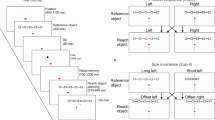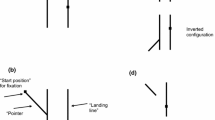Abstract
The visual localisation of objects in space is thought to rely on retinal information defining the environmental context and non-retinal cues from proprioception and motor commands. Here, the influence of dynamic contextual cues on the perception of egocentric space in a reaching task was investigated. Compared to performances with realistic motion or static cues, target localisation was less accurate when apparent motion was used to provide contextual information about space between the hand and the target. This effect could not be explained by the 'presence' of motion, or a bias in depth perception. Since the distortion was connected with the reaching area it was concluded that cognitive factors can unconsciously influence the perception of egocentric space, in particular distance estimation. We propose a mechanism for this whereby signals from areas MT/MST (middle temporal/medial superior temporal) create a perceptual bias through cortico-cortical connections with posterior parietal cortex.



Similar content being viewed by others
References
Andersen RA, Bradley DC (1998) Perception of three-dimensional structure from motion. Trends Cogn Sci 2:222–228
Andersen RA, Snyder LH, Bradley DC, Xing J (1997) Multimodal representation of space in the posterior parietal cortex and its use in planning movements. Annu Rev Neurosci 20:303–330
Berthier NE, Clifton RK, Gullapalli V, McCall DD, Robin D (1996) Visual information and object size in the control of reaching. J Motor Behav 28:187–197
Boring EG (1957) A history of experimental psychology. 2nd edn. Prentice Hall, Englewood Cliffs, NJ
Boulton JC, Baker CL (1993) Dependence on stimulus onset asynchrony in apparent motion—evidence for 2 mechanisms. Vision Res 33:2013–2019
Bridgeman B (1986) Multiple sources of outflow in processing spatial information. Acta Psychol 63:35–48
Bridgeman B, Graziano JA (1989) Effect of context and efference copy on visual straight ahead. Vision Res 29:1729–1736
Bruno N, Cutting J (1988) Minimodularity and the perception of layout. J Exp Psychol Gen 117:161–170
Bulthoff I, Bulthoff H, Sinha P (1998) Top-down influences on stereoscopic depth-perception. Nature Neurosci 1:254–257
Caelli T, Finlay D (1981) Intensity, spatial frequency, and temporal frequency determinants of apparent motion: Korte revisited. Perception 10:183–189
Castet E, Lorenceau J, Bonnet C (1993) The inverse intensity effect is not lost with stimuli in apparent motion. Vision Res 33:1697–1708
Coello Y, Grealy MA (1997) Effect of size and frame of visual field on the accuracy of a pointing movement. Perception 26:287–300
Coello Y, Magne P (2000) Determination of target distance in a structured environment: selection of visual information for action. Eur J Cogn Psychol 12:489–519
Coello Y, Orliaguet JP, Prablanc C (1996) Pointing movement in an artificial perturbing inertial field: a prospective paradigm for motor control study. Neuropsychologia 34:879–892
Coello Y, Magne P, Plenacoste P (2000) The contribution of retinal signal to the specification of target distance in a visuo-manual task. Curr Psychol Lett 3:75–89
Conti P, Beaubaton D (1980) Role of structured visual field and visual reafference in accuracy of pointing movements. Percept Motor Skills 50:239–244
DeAngelis GC (2000) Seeing in three dimensions: the neurophysiology of stereopsis. Trends Cogn Sci 4:80–90
Desmurget M, Pelisson D, Rossetti Y, Prablanc C (1998) From eye to hand: planning goal directed movements. Neurosci Behav Rev 22:761–788
Desmurget M, Epstein CM, Turner RS, Prablanc C, Alexander GE, Grafton ST (1999) Role of the posterior parietal cortex in updating reaching movements to a visual target. Nature Neurosci 2:563–567
Foley JM, Held R (1972) Visually directed pointing as a function of target distance. Percept Psychophys 12:263–268
Goebel R, Khorram-Sefat D, Muckli L, Hacker H, Singer W (1998) The constructive nature of vision: direct evidence from functional magnetic resonance imaging studies of apparent motion and motion imagery. Eur J Neurosci 10:1563–1573
Jeannerod M (1988) The neural and behavioral organization of goal directed movements. Oxford University Press, Oxford
Kaneoke Y, Bundou M, Koyama S, Suzuki H, Kakigi R (1997) Human cortical area responding to stimuli in apparent motion. Neuroreport 8:677–682
Kourtzi Z, Kanwisher N (2000) Activation in human MT/MST by static images with implied motion. J Cogn Neurosci 12:48–55
Magne P, Coello Y (2002) Retinal and extra-retinal contribution to position coding. Behav Brain Res (in press)
Matin L, Picoult E, Stevens JK, Edwards MW, Young D, Macarthur R (1982) Oculoparalytic illusion—visual-field dependent spatial mislocalizations by humans partially paralyzed with curare. Science 216:198–201
Milner AD, Goodale MA (1995) The visual brain in action. Oxford University Press, Oxford
Mon-Williams M, Tresilian JR (1999) Some recent studies on the extraretinal contribution to distance perception. Perception 28:167–181
Mon-Williams M, Tresilian JR, Roberts A (2000) Vergence provides veridical depth perception from horizontal retinal image disparities. Exp Brain Res 133:407–413
Mon-Williams M, Tresilian JR, McIntosh RD, Milner AD (2001) Monocular and binocular distance cues: insights from visual form agnosia I (of III). Exp Brain Res 139:127–136
Norman J (2003) Two visual systems and two theories of perception: an attempt to reconcile the constructivist and ecological approaches. Behav Brain Sci (submitted). http://www.bbsonline.org/documents/a/00/00/05/11/index.html
Orban GA, Sunaert S, Todd JT, Van Hecke P, Marchal G (1999) Human cortical regions involved in extracting depth from motion. Neuron 24:929–940
Pélisson D, Prablanc C, Goodale MA, Jeannerod M (1986) Visual control of reaching movements without vision of the limb. II. Evidence of fast unconscious processes correcting the trajectory of the hand to the final position of a double-step stimulus. Exp Brain Res 62:303–311
Prablanc C, Echallier JE, Jeannerod M, Komilis E (1979) Optimal response of eye and hand motor systems in pointing at a visual target. II. Static and dynamic visual cues in the control of hand movement. Biol Cybern 35:183–187
Rossetti Y, Pisella L (2002) Several 'vision for action' systems: a guide to dissociating and integrating dorsal and ventral functions. In: Prinz W, Hommel B (eds) Attention and performance XIX: common mechanisms in perception and action. Oxford University Press, Oxford (in press)
Tootell RBH, Reppas JB, Kwong KK, Malach R, Born RT, Brady TJ, Rosen BR, Belliveau JW (1995) Functional-analysis of human Mt and related visual cortical areas using magnetic-resonance-imaging. J Neurosci 15:3215–3230
Tresilian JR, Mon-Williams M, Kelly BM (1999) Increasing confidence in vergence as a cue to distance. Proc R Soc Lond B Biol Sci 266:39–44
van der Heijden AHC, Müsseler J, Bridgeman B (1999) On the perception of position. In: Aschersleben G, Bachmann T, Müsseler J (eds) Cognitive contributions to the perception of spatial and temporal events. Elsevier, Amsterdam, pp. 19–37
Watson JDG, Myers R, Frackowiak RSJ, Hajnal JV, Woods RP, Mazziotta JC, Shipp S, Zeki S (1993) Area V5 of the human brain—evidence from a combined study using positron emission tomography and magnetic resonance imaging. Cereb Cortex 3:79–94
Whitney D, Cavanagh P (2000) Motion distorts visual space: shifting the perceived position of remote stationary objects. Nature Neurosci 3:954–959
Wolpert DM, Goodbody SJ, Husain M (1998) Maintaining internal representations: the role of the human superior parietal lobe. 1:529–533
Yantis S, Nakama T (1998) Visual interactions in the path of apparent motion. Nature Neurosci 1:508–512
Zeki S, Watson JDG, Frackowiak RSJ (1993) Going beyond the information given: the relation of illusory visual motion to brain activity. Proc R Soc Lond B Biol Sci 252:215–222
Author information
Authors and Affiliations
Corresponding author
Rights and permissions
About this article
Cite this article
Grealy, M.A., Coello, Y. & Heffernan, D. Apparent motion cues distort object localisation in egocentric space. Exp Brain Res 150, 356–362 (2003). https://doi.org/10.1007/s00221-003-1426-4
Received:
Accepted:
Published:
Issue Date:
DOI: https://doi.org/10.1007/s00221-003-1426-4




